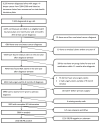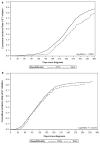Racial disparities in initiation of adjuvant endocrine therapy of early breast cancer - PubMed (original) (raw)
Racial disparities in initiation of adjuvant endocrine therapy of early breast cancer
Katherine E Reeder-Hayes et al. Breast Cancer Res Treat. 2014 Jun.
Abstract
Endocrine therapy (ET) is the cornerstone of adjuvant therapy for hormone-receptor positive (HR+) breast cancer. The survival gap between African-American (AA) and white women with breast cancer is most pronounced in HR+ subtypes, and could be related to differences in ET use. The relationship between race and initiation of ET is not well defined. We investigated patterns of ET initiation by race in a diverse cohort of women covered by commercial health insurance. We identified 2,640 women with incident HR+ breast cancer in the North Carolina Central Cancer Registry whose records linked to commercial insurance claims using the Integrated Cancer Information and Surveillance System (ICISS) database. The sample included women age <65 years diagnosed with stage I-III HR+ cancers between 2004 and 2009. We used multivariate Poisson regression to examine the effect of race on likelihood of initiating ET. 14 % of women did not initiate ET within 12 months of diagnosis. AA women were 17 % less likely to initiate ET than whites (aRR 0.83, 95 % CI 0.74-0.93). When analyzed by subset, racial disparities persisted among women who received chemotherapy (aHR 0.67, 95 % CI 0.56-0.80) but not among women who did not receive chemotherapy (aHR 0.96, 95 % CI 0.76-1.21). AA women in our sample were less likely to initiate ET than whites, and this disparity was concentrated among chemotherapy-treated women. ET under-utilization may contribute to the racial survival gap in HR+ breast cancer, and represents an opportunity for intervention to reduce breast cancer disparities.
Conflict of interest statement
Conflict of interest The authors have declared that they have no financial conflicts of interest.
Figures
Fig. 1
Cohort diagram
Fig. 2
Cumulative rates of endocrine therapy initiation by race at 12 months post-diagnosis among chemotherapy-treated women (panel a) and women who did not receive chemotherapy (panel b)
Similar articles
- Racial differences in receipt of adjuvant hormonal therapy among Medicaid enrollees in South Carolina diagnosed with breast cancer.
Felder TM, Do DP, Lu ZK, Lal LS, Heiney SP, Bennett CL. Felder TM, et al. Breast Cancer Res Treat. 2016 May;157(1):193-200. doi: 10.1007/s10549-016-3803-2. Epub 2016 Apr 27. Breast Cancer Res Treat. 2016. PMID: 27120468 Free PMC article. - Disparities in Use of Human Epidermal Growth Hormone Receptor 2-Targeted Therapy for Early-Stage Breast Cancer.
Reeder-Hayes K, Peacock Hinton S, Meng K, Carey LA, Dusetzina SB. Reeder-Hayes K, et al. J Clin Oncol. 2016 Jun 10;34(17):2003-9. doi: 10.1200/JCO.2015.65.8716. Epub 2016 Apr 11. J Clin Oncol. 2016. PMID: 27069085 Free PMC article. - A tracking and feedback registry to reduce racial disparities in breast cancer care.
Bickell NA, Shastri K, Fei K, Oluwole S, Godfrey H, Hiotis K, Srinivasan A, Guth AA. Bickell NA, et al. J Natl Cancer Inst. 2008 Dec 3;100(23):1717-23. doi: 10.1093/jnci/djn387. Epub 2008 Nov 25. J Natl Cancer Inst. 2008. PMID: 19033569 Free PMC article. - The optimal duration of adjuvant endocrine therapy for early stage breast cancer--with what drugs and for how long?
Johnston SR, Yeo B. Johnston SR, et al. Curr Oncol Rep. 2014;16(1):358. doi: 10.1007/s11912-013-0358-9. Curr Oncol Rep. 2014. PMID: 24390724 Review. - Selecting adjuvant endocrine therapy for breast cancer.
Eneman JD, Wood ME, Muss HB. Eneman JD, et al. Oncology (Williston Park). 2004 Dec;18(14):1733-44, discussion 1744-5, 1748, 1751-4. Oncology (Williston Park). 2004. PMID: 15700624 Review.
Cited by
- Impact of patient race and geographical factors on initiation and adherence to adjuvant endocrine therapy in medicare breast cancer survivors.
Camacho FT, Tan X, Alcalá HE, Shah S, Anderson RT, Balkrishnan R. Camacho FT, et al. Medicine (Baltimore). 2017 Jun;96(24):e7147. doi: 10.1097/MD.0000000000007147. Medicine (Baltimore). 2017. PMID: 28614244 Free PMC article. - Racial and Geographic Disparities in Endocrine Therapy Adherence Among Younger Breast Cancer Survivors.
Heiney SP, Truman S, Babatunde OA, Felder TM, Eberth JM, Crouch E, Wickersham KE, Adams SA. Heiney SP, et al. Am J Clin Oncol. 2020 Jul;43(7):504-509. doi: 10.1097/COC.0000000000000696. Am J Clin Oncol. 2020. PMID: 32251120 Free PMC article. - Racial Differences in Breast Cancer Survival Between Black and White Women According to Tumor Subtype: A Systematic Review and Meta-Analysis.
Torres JM, Sodipo MO, Hopkins MF, Chandler PD, Warner ET. Torres JM, et al. J Clin Oncol. 2024 Nov 10;42(32):3867-3879. doi: 10.1200/JCO.23.02311. Epub 2024 Sep 17. J Clin Oncol. 2024. PMID: 39288352 - Perspectives of older women with early breast cancer on telemedicine during post-primary treatment.
Buse CR, Kelly EAO, Muss HB, Nyrop KA. Buse CR, et al. Support Care Cancer. 2022 Dec;30(12):9859-9868. doi: 10.1007/s00520-022-07437-0. Epub 2022 Nov 15. Support Care Cancer. 2022. PMID: 36378342 Free PMC article.
References
- Edwards BK, Brown ML, Wingo PA, Howe HL, Ward E, Ries LA, Schrag D, Jamison PM, Jemal A, Wu XC, Friedman C, Harlan L, Warren J, Anderson RN, Pickle LW. Annual report to the nation on the status of cancer, 1975–2002, featuring population-based trends in cancer treatment. J Natl Cancer Inst. 2005;97(19):1407–1427. doi: 10.1093/jnci/dji289. - DOI - PubMed
Publication types
MeSH terms
Substances
LinkOut - more resources
Full Text Sources
Other Literature Sources
Medical
Miscellaneous

